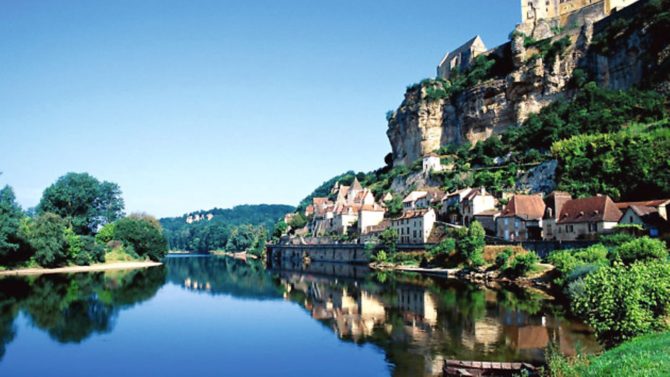Dordogne or Lot: which one should I choose?

Settled on south-west France but struggling to choose between popular Dordogne and lesser-known Lot? We look at the virtues of each

The neighbouring departments of Dordogne and Lot share everything we love about the country – from quaint villages bathed in sunshine to heritage, gorgeous food and wine and pristine scenery where rivers meander through lush countryside or carve their way below spectacular cliffs. For decades Dordogne has attracted British expats, but Lot is just beginning to reveal its charm on this side of the Channel.
Lot
Region: Languedoc-Roussillon-Midi-Pyrénées

Land area: 5,217sqkm
Population: 173,758
Average house price: €124,800
In the ancient province of Quercy, character and variety are the mainstay of this small department, rich in traditions and landscapes. Here you’ll find the sparsely inhabited plateau of the Causses du Quercy, a parc naturel régional sprinkled with dovecotes and shepherds’ huts; then there’s the dramatic chasm of Padirac or the prehistoric caves of Pech Merle; the granite hills of Ségala and their fast flowing streams; or the vineyards of Cahors down south in the bucolic Lot Valley.
Cahors is a modest capital (around 20,000 inhabitants) with surprising attractions such as its vin noir, the most powerful of the wines produced in Lot. Nestling in a beautiful river loop, the town is dotted with ‘secret gardens’, medieval arcades and Renaissance houses, while St Stephen’s cathedral keeps watch over the city’s true icon, the 14th-century fortified Pont Valentré.
Heading west along the meandering Lot river you come to Luzech, a pretty village in the fold of the hills, almost enclosed by the water, and Puy-l’Evêque draped in old merchants’ houses and winding lanes named after ancient trades. East of Cahors, the clifftop village of St-Cirq-Lapopie rises like a mirage high above the river in a tangle of steep cobbled lanes and flower-filled balconies. It’s listed among France’s Plus Beaux Villages and a favourite haunt for artists and craftsmen.
It may be tempting to venture no further than this stunning valley, but Rocamadour beckons with monastic buildings and churches clinging to ochre-coloured cliffs above the gorge of the Adour. It’s a breathtaking sight for pilgrims on their way to Compostela and tourists keen to enjoy the view and the local goat’s cheese. The Adour is a tributary of the Dordogne which flows across the northern reaches of the department, taking in a few castles: Castelnau-Bretenoux, Belcastel, La Treyne, and a scattering of villages like Carennac, Loubressac or Autoire with its waterfall.
Find properties for sale in Lot on France Property Shop
Read more: 8 reasons you should buy a property in Midi-Pyrénées
Region: Aquitaine-Limousin-Poitou-Charentes
Land area: 9,060sqkm
Population: 416,909
Average house price: €110,700
North-west of the old Quercy province, the Dordogne department boasts a long and often turbulent history, including 300 years of English rule in the Middle Ages. It’s a scenic land of Plus Beaux Villages and castles, prehistoric caves and picturesque towns of history and art. The Périgord, as it was formerly known, enjoys a mild climate year round and a diversity symbolised by four main colours.
At the heart of the province, the Périgord Blanc is an area of limestone plateaux, wide valleys and rolling grasslands. There, on the banks of the River Isle, the préfecture Périgueux has three museums, a cathedral and an enticing mix of medieval and Renaissance architecture. The Périgord Vert to the north encompasses part of the Périgord-Limousin nature reserve, the Dronne valley and the lovely town of Brantôme with its abbey and stone bridge. In the south-west it’s purple for the vineyards, be it the sweet Monbazillac or the red AOCs from Bergerac, a historic town on the Dordogne river with a number of half-timbered houses.
But best known is the Périgord Noir in the south east, where dark oak forests hide truffles and cèpes, perfect accompaniments to duck and goose dishes. Sarlat, the main town, is all medieval and Renaissance buildings in ochre-coloured stone while the nearby Vézère valley contains numerous prehistoric sites listed by UNESCO, most famous the painted caves of Lascaux (closed to the public, but you can see reproductions in Lascaux II).
Meanwhile, the Dordogne river gently follows its course from east to west, past Domme, a medieval bastide with sturdy fortifications, and two of France’s Plus Beaux Villages: La Roque-Gageac, squeezing precariously below the cliffs, and Beynac-et-Cazenac with its eagle’s-nest castle looking across the peaceful valley.
Find properties for sale in Dordogne on France Property Shop
Like this? You might enjoy:
10 beautiful Dordogne Valley villages you must visit5 things to consider before buying a rural retreat in France
Share to: Facebook Twitter LinkedIn Email


